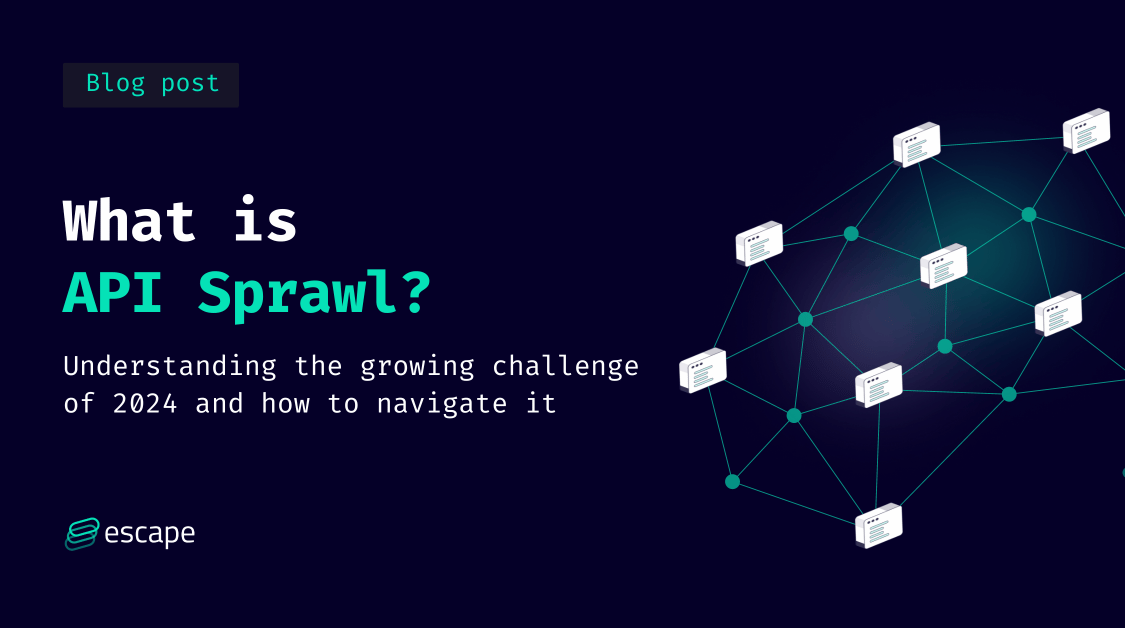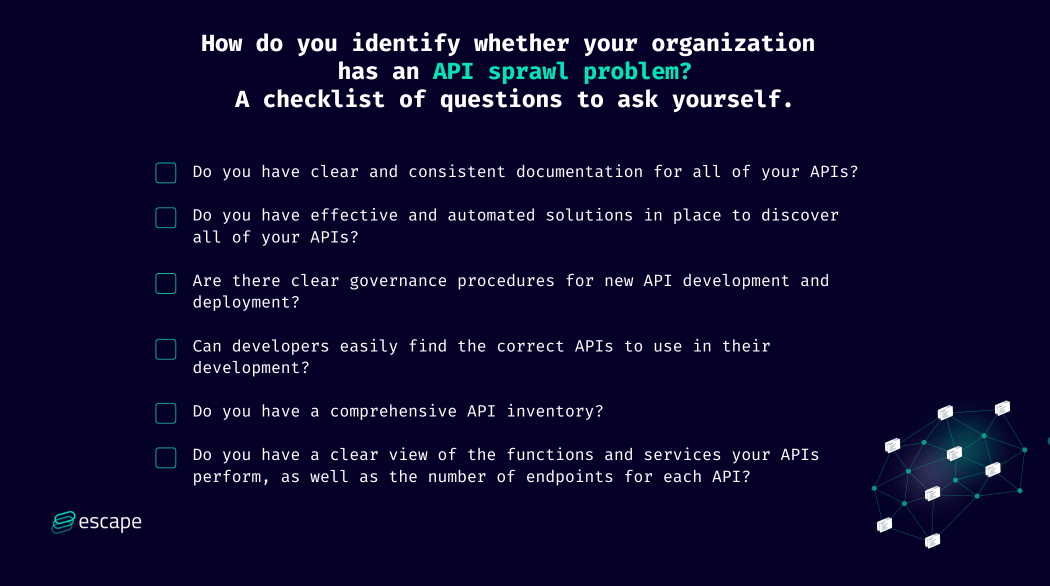
2024-2-27 20:41:36 Author: securityboulevard.com(查看原文) 阅读量:1 收藏

Do you know all your organization's APIs? The more security engineers reach out to us, the more we understand that it's rare for them to have complete visibility and control over all of their organization's APIs.
API sprawl is a growing challenge in 2024; Metrics aside (if you're a data fan, no worries, we'll provide more data below), think content – in January and February alone, I've seen multiple articles appearing on this topic. An editor-in-chief of Nordic APIs, Bill Doerrfeld, has been very vocal about it.
The API Sprawl issue will continue to grow even further. Just think that by 2027, APIs will have a projected global economic impact of $14.2 trillion – more than GDPs of Germany, France, and Japan combined. Crazy, don't you think?
We believe that by that time, every organization will be API-first and will need to implement robust security systems in place for their APIs. But before even starting to implement API security solutions, you should define what you need to secure. You can't secure what you can't see, right?
Dive into this article to find out how API sprawl might concern you and what solutions you can implement to mitigate it.
What is API sprawl?
If you're new to the API economy, here's a brief definition of what we mean by API sprawl:
💡
API sprawl is the uncontrolled proliferation and decentralized management of Application Programming Interfaces (APIs) within an organization.
Ok, but how did we arrive at the point where we have challenges in controlling APIs developed by our organizations?
The emergence of APIs and the onset of API sprawl
In the early 2000s, APIs revolutionized the way businesses operated online. They provided a strategic gateway for integrating third-party services, enhancing capabilities, and promoting interoperability. However, as organizations expanded and sought innovation, the development of APIs significantly increased.
With the increase of the development, came the increase in exposure. According to Gartner, 80% of organizations provide or are planning to provide publicly exposed APIs.
The challenge emerged when distinct teams within an organization independently created their own APIs without central coordination or standardization. Imagine an average enterprise organization with hundreds of developers; how can you control what they're building? Even in small startups, it's hard. The need for speed (even though we're out of the "Fast and Furious" era) also overpowers the need for API governance and documentation.
Most organizations simply don’t have visibility into how many APIs they have, where those APIs reside, and what those APIs are doing.
The rise of microservices architecture and focus on DevOps have also been factors contributing to the API sprawl. Microservices teams often become isolated from one another. And if the organization doesn't have good communication systems in place, its developers just stop sharing best practices and collaborate on API design.
In the DevOps approach, the software is pushed out frequently in small steps. These incremental changes can sometimes cause instability in the APIs, and some developers might start building their own stable APIs instead of dealing with things that are constantly broken.
This lack of control and good communication practices resulted in today's complicated landscape of APIs, leading to the onset of API sprawl.
Why should you really care?
Indeed, why should you really care about API sprawl? The answer is simple – API sprawl introduces several operational and security challenges for your organization.
API security
Well, first of all, with so many different APIs, it is highly challenging to keep track of who has access to which API and what data can be accessed with it. The lack of awareness of access and authority can lead to an increased risk of security issues and even serious data breaches. Just think about the lessons we learned from the latest API security breaches, all happened just at the beginning of 2024.
Again, you can't secure, what you can't see.
Lack of visibility & absence of a clear source of truth
Another key challenge is the lack of visibility into the hybrid infrastructure where APIs are deployed. With organizations operating across multiple architectures, including public clouds, on-premises data centers, and edge infrastructure, it becomes extremely difficult to have a unified view of APIs, API traffic and configurations.
With a lack of visibility comes the absence of a clear source of truth for APIs. Developers often struggle to discover APIs and access up-to-date documentation, making it difficult to understand and use existing APIs effectively. This lack of documentation and visibility also leads to a decrease in reliability, as misconfigurations become more common, resulting in potential outages.
More development and maintenance costs
Lack of communication in large organizations might lead to the teams doing duplicate work in API development. Thus resulting in higher costs for organizations – both in terms of time spent and potentially in deploying and storing redundant information.
Decreased agility and productivity
Decreased productivity is another of the most common consequences of API sprawl. This is damaging both for individual psychology and for organizations.
On a personal level, with too many APIs, developers might feel they're wasting time spent searching and, eventually, become frustrated with the current state of things.
On a business level, with so many different APIs existing without a proper API catalog, it can be challenging to make changes quickly. Failure to react and adapt rapidly to the changing business needs can lead to missed opportunities and a competitive disadvantage.
How do you identify whether your organization has an API sprawl problem?
A checklist of questions to ask yourself:
- Do you have clear and consistent documentation for all of your APIs?
- Do you have effective and automated solutions in place to discover all of your APIs?
- Are there clear governance procedures for new API development and deployment?
- Can developers easily find the correct APIs to use in their development?
- Do you have a comprehensive API inventory?
- Do you have a clear view of the functions and services your APIs perform, as well as the number of endpoints for each API?

If the answer is 'no' to any of these questions, you do have an API sprawl problem to fix or might be at risk of developing it in the future. In doubts? You can also join this Slack community and ask other professionals there.
Only by acknowledging the presence of a problem can you start mitigating it.
Mitigating API sprawl: Strategies and solutions
To address the challenges posed by API sprawl, you need to implement proper API management and governance practices in your organization. Here are some strategies and solutions that can help mitigate the risks associated with API sprawl:
Implement an API governance strategy
Establishing an API governance strategy is crucial for managing the proliferation of APIs. This strategy should include standardized processes and guidelines for API development, documentation, and security. By enforcing governance policies, organizations can ensure that APIs adhere to best practices and meet the necessary security requirements.
Create a single source of truth for APIs with automated solutions
To combat the lack of visibility and documentation caused by API sprawl, organizations should create a centralized repository or API catalog that serves as a single source of truth for all APIs. This repository should provide comprehensive information about each API, including its purpose, functionality, documentation, and access controls. Developers can then easily discover and access the APIs they need, reducing redundancy and facilitating collaboration.
Keep in mind that the best way to create your single source of truth is the automated way.
Applying API discovery at scale
Automated API discovery and API inventory should be a top priority for organizations dealing with API sprawl.
With the right tools organizations create a single source of truth for APIs, ensure an up-to-date API catalog, provide metrics and visibility, and apply API security at scale.
Escape's API discovery tool provides a comprehensive set of features for fighting API sprawl and managing APIs at scale.
Additionally, Escape offers a wide range of solutions to address specific security concerns related to API sprawl. We help to protect APIs from OWASP Top 10 and business logic exploits. If you're still in doubt, see how Escape can reduce your organization's risk for yourself with our ROI calculator.
Ensure proper versioning and documentation
Proper versioning and documentation are essential for managing APIs at scale. Organizations should implement version control mechanisms to track changes and updates to APIs, ensuring backward compatibility and facilitating seamless integration with existing applications. Additionally, thorough documentation should be maintained for each API, including detailed descriptions, usage instructions, and examples, enabling developers to understand and utilize APIs effectively.
Provide metrics and visibility
To gain visibility into API usage and performance, organizations should implement monitoring and analytics tools. These tools can provide real-time insights into API traffic, response times, error rates, and other key metrics, enabling organizations to identify bottlenecks, detect anomalies, and optimize API performance. By having access to comprehensive metrics and visibility, organizations can make informed decisions about API management and improve overall efficiency.
Final thoughts
API sprawl is a significant challenge that organizations must address to ensure the security and efficiency of their operations. By implementing proper API management and governance practices, organizations can mitigate the risks associated with API sprawl.
Fixing your API sprawl will help you reduce the risk of data breaches, improve your ability to deliver faster and more reliable systems, and increase developer satisfaction.
Solutions like Escape's automated API discovery and security provide the necessary tools and expertise to manage APIs effectively and ensure your organization's security at scale.
In the end, managing API sprawl will always be an ongoing process that requires continuous monitoring, adaptation, and improvement. Stay proactive and implement truly efficient solutions, and you can navigate the challenges of API sprawl with ease!
💡 Want to learn more?
Discover the following articles:
- What is API discovery, and how does it work? The differences between manual and automated approaches
- API Catalog & API Portal: A handbook of everything you should know
- API gateway security: 8 best practices
*** This is a Security Bloggers Network syndicated blog from Escape - The API Security Blog authored by Alexandra Charikova. Read the original post at: https://escape.tech/blog/what-is-api-sprawl/
如有侵权请联系:admin#unsafe.sh